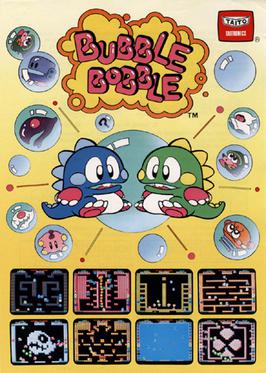
Bubble Bobble is a 1986 platform game developed and published by Taito for arcades. It was distributed in the United States by Romstar, and in Europe by Electrocoin. Players control Bub and Bob, two dragons that set out to save their girlfriends from a world known as the Cave of Monsters. In each level, Bub and Bob must defeat each enemy present by trapping them in bubbles and popping, who turn into bonus items when they hit the ground. There are 100 levels total, each becoming progressively more difficult.
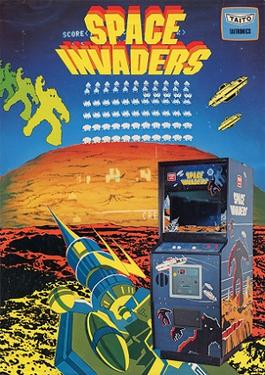
Space Invaders is a 1978 shoot 'em up arcade video game, developed and released by Taito in Japan and licensed to Midway Manufacturing for overseas distribution. Commonly considered to be one of the most influential video games of all time, Space Invaders was the first fixed shooter and the first video game with endless gameplay and set the template for the genre. The goal is to defeat wave after wave of descending aliens with a horizontally moving laser cannon to earn as many points as possible.

Area 51 is a light gun arcade game released by Time Warner Interactive in 1995. It takes its name from the military facility. The plot of the game involves the player taking part in a Strategic Tactical Advanced Alien Response (STAAR) military incursion to prevent aliens, known as the Kronn, and alien-created zombies from taking over the Area 51 military facility.

Star Control: Famous Battles of the Ur-Quan Conflict, Volume IV is an action-strategy video game developed by Toys for Bob and published by Accolade. It was originally released for MS-DOS and Amiga in 1990, followed by ports for the Sega Genesis and additional platforms in 1991. The story is set during an interstellar war between two space alien factions, with humanity joining the Alliance of Free Stars to defeat the invading Ur-Quan Hierarchy. Players can choose to play as either faction, each with seven different alien starships which are used during the game's combat and strategy sections.

Zaxxon is a scrolling shooter developed and released by Sega as an arcade video game in 1982. The player pilots a ship through heavily defended space fortresses. Japanese electronics company Ikegami Tsushinki was also involved in the game's development.

Contra is a run and gun video game developed and published by Konami, originally developed as a coin-operated arcade video game in 1986 and released on February 20, 1987. A home version was released for the Nintendo Entertainment System in 1988, along with ports for various home computer formats, including the MSX2. The arcade and computer versions were localized as Gryzor in Europe, and the NES version as Probotector in PAL regions and France.

Defender is a horizontally scrolling shooter developed by Williams Electronics in 1980 and released as an arcade video game in 1981. The game is set on either an unnamed planet or city where the player must defeat waves of invading aliens while protecting astronauts. Development was led by Eugene Jarvis, a pinball programmer at Williams; Defender was Jarvis's first video game project and drew inspiration from Space Invaders and Asteroids. Defender was demonstrated in late 1980, before entering production in early 1981. It was distributed in Japan by Taito.
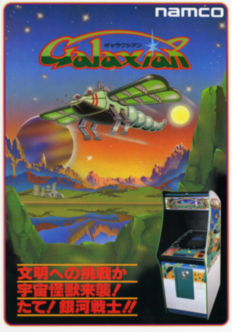
Galaxian is a 1979 fixed shooter arcade video game developed and published by Namco. The player assumes control of the Galaxip starfighter in its mission to protect Earth from waves of aliens. Gameplay involves destroying each formation of aliens, who dive down towards the player in an attempt to hit them.
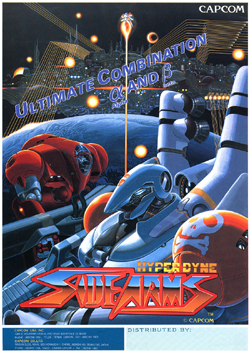
Hyper Dyne Side Arms (サイドアーム) is a horizontally scrolling shooter developed and released by Capcom as an arcade video game in 1986. The player takes control of a flying mecha fighter who must battle an alien army. Side Arms uses a two-directional attacking system similar to Capcom's previous shoot-'em-up Section Z.

Air Fortress is a run-and-gun video game developed and published by HAL Laboratory for the Nintendo Entertainment System. It was released in Japan in August 1987, in North America in September 1989 after an initial test release of 385 copies in 1987, and an Australian release in 1989.
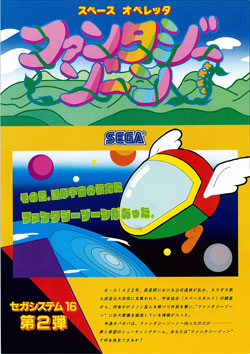
Fantasy Zone is a 1986 arcade video game by Sega, and the first game in the Fantasy Zone series. It was later ported to a wide variety of consoles, including the Master System. The player controls a sentient spaceship named Opa-Opa who fights an enemy invasion in the titular group of planets. The game contains a number of features atypical of the traditional scrolling shooter. The main character, Opa-Opa, is sometimes referred to as Sega's first mascot character.
1979 saw many sequels and prequels in video games, such as Space Invaders Part II and Super Speed Race, along with new titles such as Asteroids, Football, Galaxian, Head On, Heiankyo Alien, Monaco GP, Sheriff and Warrior. For the second year in a row, the highest-grossing video game was Taito's arcade game Space Invaders and the best-selling home system was the Atari Video Computer System.

The Simpsons: Bart's House of Weirdness is a platform video game published by Konami on January 1, 1992 for MS-DOS. Developed by Distinctive Software, it is based on the Simpsons franchise and features many aspects from the series. In the game, the player controls Bart as he escapes from the Simpsons' house after being grounded by his parents. On his adventures throughout town, Bart is equipped with various weapons that are used to fend off enemies and animals. Bart's House of Weirdness does not have a wide fan base because it was only released for DOS, but the early reviews of the game were positive, at least in terms of graphics and sound.

Stellar 7 is a first-person tank simulation video game based on the 1980s arcade game Battlezone in which the player assumes the role of a futuristic tank pilot. The game was created by Damon Slye for the Apple II and Commodore 64 in 1983, then remade in the early 1990s for MS-DOS, Amiga, and Classic Mac OS. There are three sequels: Arcticfox (1986), Nova 9: The Return of Gir Draxon (1991), and Stellar 7: Draxon's Revenge (1993).

Space Panic is a 1980 arcade video game developed by Universal. Predating Nintendo's Donkey Kong, and lacking a jump mechanic, Space Panic was the first game involving climbing ladders between walkable platforms. The genre was initially labeled "climbing games", but later became known as platform games. A ColecoVision port by CBS Electronics was released in the winter holiday season of 1982.
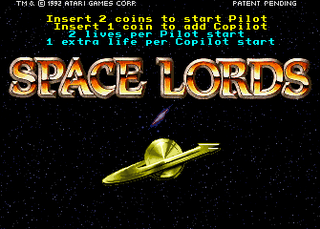
Space Lords is a video game released in arcades by Atari Games in 1992. It is a first-person perspective space combat video game.

Space Gun is a 1990 first-person shooter arcade game released by Taito. The game is set aboard a crippled space station that has been overrun by hostile alien creatures. The objective is to rescue human crew members while destroying the alien creatures. The game lets the player shoot limbs off the creatures, resulting in blood splatters.

Heiankyo Alien, known as Digger in North America, is a maze video game created by The University of Tokyo's Theoretical Science Group (TSG) in 1979. The game was originally developed and released as a personal computer game in 1979, and was then published by Denki Onkyō Corporation as an arcade game in November 1979. In 1980, the arcade game was released in North America as Digger by Sega-Gremlin, with minor changes in appearance.

Magnetron is a 1988 video game published by Broderbund.

Super Spacefortress Macross is a 1992 vertically scrolling shooter arcade video game developed NMK and published by Banpresto. Based upon the 1984 anime film Macross: Do You Remember Love?, it is the first arcade entry in the Macross franchise. In the game, the players control the VF-1 Valkyrie variable mecha fighters, piloted by Hikaru Ichijyo and Max Jenius, in a battle against the Zentradi alien race.


















